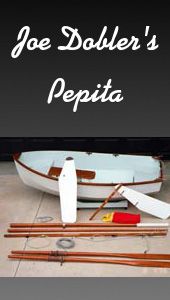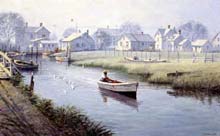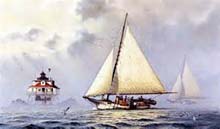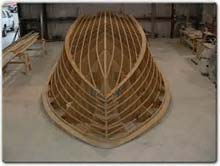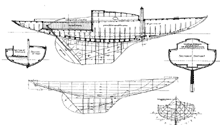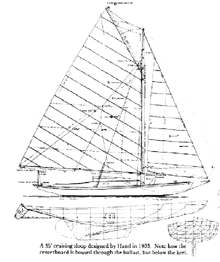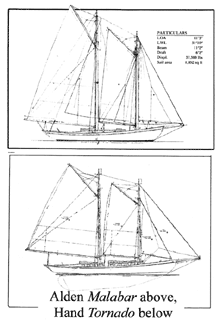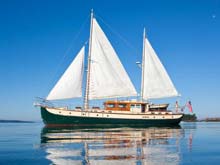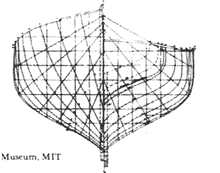
 Custom Search
|
| boat plans |
| canoe/kayak |
| electrical |
| epoxy/supplies |
| fasteners |
| gear |
| gift certificates |
| hardware |
| hatches/deckplates |
| media |
| paint/varnish |
| rope/line |
| rowing/sculling |
| sailmaking |
| sails |
| tools |
| join |
| home |
| indexes |
| classifieds |
| calendar |
| archives |
| about |
| links |
| Join Duckworks Get free newsletter CLICK HERE |
|
|
| Out There |
by Paul Austin - Dallas, Texas - USA By Hand and Eye |
 |
Often success chooses the man, rather than the man being a success. This was the case for the famous ship designer William Hand. After the Civil War, the competition among designers Nathaniel Herreshoff, B. B. Crowninshield, John Alden and Charles Mower was fierce as the country spread west over land. That competition enabled William Hand to find his particular place in ship design. With the Civil War over, hundreds of seamen came ashore due to post-war reductions in the Navy. Not only was there no payroll for seamen, so many ships had been sunk or scuttled, there was nearly nothing to sail. One of those sailors who came ashore was William Hand's father. The only ships to sail were the revenue cutters such as the 1871 RELIANCE, which took Hand's father to Portland ME, where William was born in 1875.
Then, when William was 11 years old, his father took him on board the revenue cutter COLFAX, bound for the Chesapeake Bay. The rest of William's life was waiting for him on the Chesapeake. There, the wide-eyed boy, hanging hands over the COLFAX bulwark, saw deadrise bugeyes, skiffs and sharpies spreading the shadow of their triangular sails over the oyster and crab grounds.
William saw how the deadrise boats could be wide on deck while still being sharp at the waterline.
When he returned to Maine, he gazed at the sloops and skiffs and fishing vessels of the day, memorizing their flare, their profiles, their deck lines and keels and gaffs like a painter would study a portrait face. He had no education or desire for mathematics and engineering, but when Hand saw a boat, he remembered it. He'd have to learn by doing and then doing it again. With no formal education in design, he didn't have any mental restrictions to believe there was only one shape of boat. So many designers drew the same boat - different lengths and widths - but the same boat over and over. Hand knew he didn't have a perfect boat in his mind but he could work toward it, with each one. By 1900 William Hand had his own design office. He must have drawn beautifully, day after day, because from 1897, nearly every issue of The Rudder Magazine had a Wm. Hand design in it. But he wasn't the only man in print. Herreshoff's yard built the massive cutters and schooners to win every yacht race on the Eastern shore, including the America's Cup.
B. B. Crowninshield drew the slippery quick personal yachts the yacht club crowd craved. So Hand drew his own racing yachts to match. But between Herreshoff's NY 30 and Crowninshield's MANCHESTER racing sloops - now known as DARK HARBOR - William seemed to know racing yachts was not going to be his signature design.
John Alden drew husky cruising schooners and sloops, so William did, also. The Alden MALABAR series was quite similar to the Hand schooner, TORNADO. MALABAR II is 41'3" while TORNADO is 45' from stem to stern. An interesting footnote to TORNADO is the engine is an oil engine, not a gas engine. The Hand schooners were certainly fast enough, but the great characteristic of William Hand is a comfortable, seaworthy craft. A writer of the time, William Taylor said of the Hand schooners,
John Alden went on to perfect his big schooners, while Hand went on in another direction. So how could William distinguish himself? He saw around him the Industrial Revolution strap gasoline engines to bicycles, cars, wagons and even boats. The Wright brothers lashed an engine between canvas and wood wings to actually fly off the ground! It was only natural that motors would come to boats. And then it hit William what he should do. Remembering the deadrise boats of the Chesapeak, he applied a v-bottom to sailing ships to create motor sailors. But motorboats were dangerous. They pounded at speed, they drenched their crews, they flipped over. The helmsman was like the college kid jumping into the washing machine at the spin cycle - he'd get bounced around, he'd get waterlogged, and he'd get thrown out dizzy. William would have to make motorboats fast without being dangerous. The deadrise Chesapeake boats would do that. And so he did. He didn't draw the perfect motorsailer right off. He drew his first successful motorsailer in 1927, called NOR'EASTER, 59' long by 16' beam. Immediately Hand knew how to improve on her. His second motorsailer, WATER WITCH had a sailing hull with a high bilge to eliminate drag at the stern.
This is what Bill Hand wrote about his design philosophy:
You can see the deadrise came from the Chesapeake Bay Bugeyes, the keel came from the schooners, the sharp entry came from the Maine skiffs and the ample stability came from Hand's own personal preferences.
He changed from the gaff rig of WATER WITCH in 1927 to the Marconi sails of BLUEFISH in 1927. Most observers felt the triangular sails allowed Hand to move the dingy davits further aft where they would be convenient. It probably also simplified the rig and the working of sails. The foredeck of BLUEFISH was raised to the sheer, giving generous room below. A Hand motorsailer is comfortable if it is anything. And yet they also sail on sails alone decently well. One of his motorsailers, SEAL, could run on sails and engine at 12 knots, and with the engine off on sails along it cruised at 9 knots. The Hand motorsailers are not as well-known today as they require serious cash to keep them up. But he drew other ships, not so large, not so expensive. Over 70 years ago, Hand drew the lines for a 35 foot ocean cruising ketch. In 1980 Joel White drew this same ketch with clean sharp lines, which was built and named ALISANDE. In Boat Design Quarterly No. 5 Mike O'Brien wrote:
Paul is also publishing his books on Amazon. |
|
